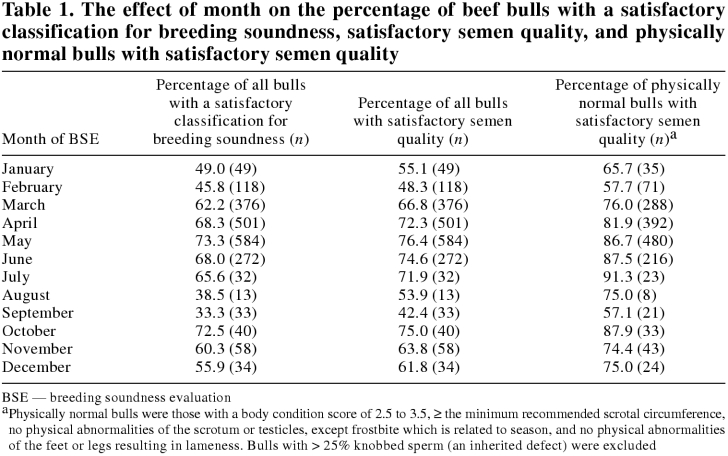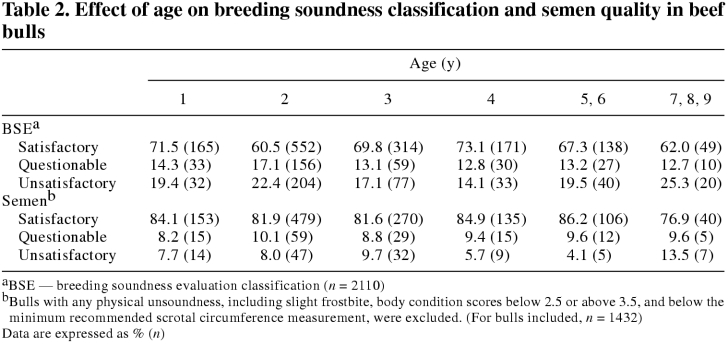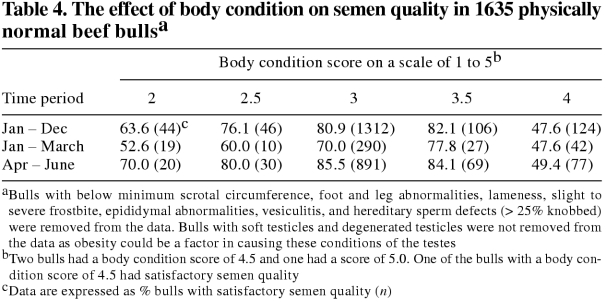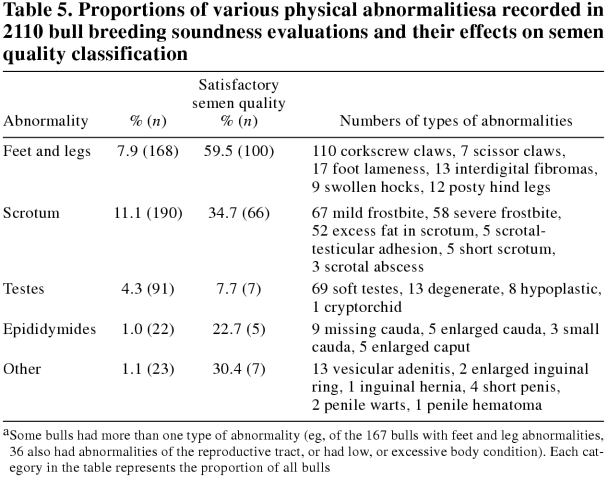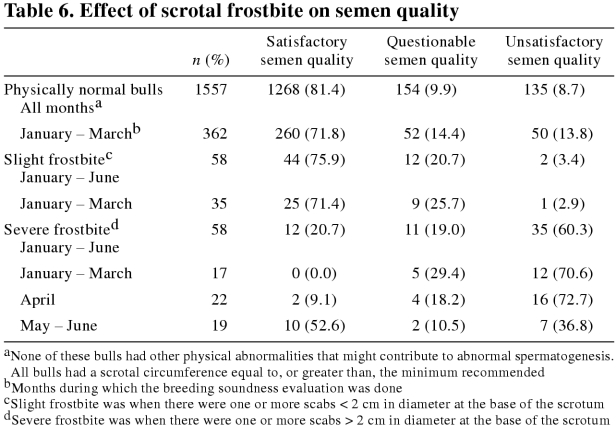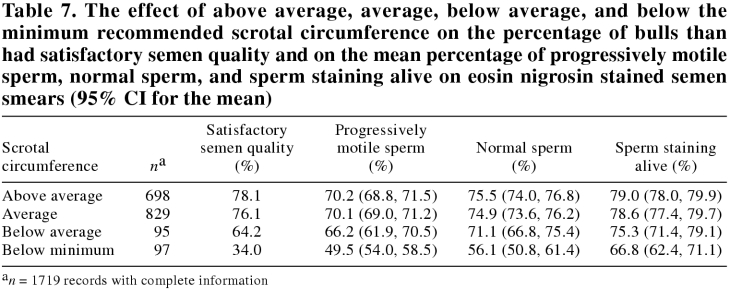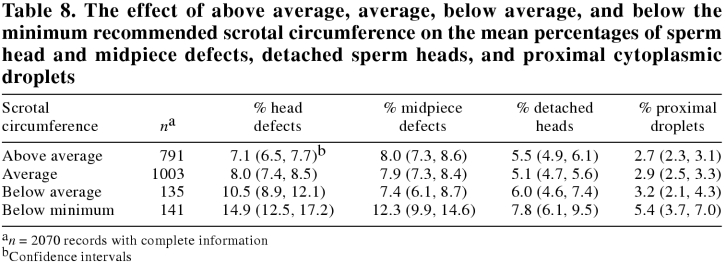Abstract
Breeding soundness evaluation records from 2110 beef bulls, for the period of 1986 to 1999, were analyzed to determine the prevalence and importance of factors affecting breeding soundness classification. The percentage of all bulls classified as satisfactory ranged from 49.0% in January to 73.3% in May. The percentage of physically normal bulls with satisfactory semen quality ranged from 65.7% in January to 87.5% in June. Poor body condition or excessive body condition, below average or below the recommended minimum scrotal circumference, lameness, and severe scrotal frostbite significantly reduced the probability of a satisfactory breeding soundness classification. The percentage of sperm with midpiece defects declined significantly and the percentage of sperm with head defects increased significantly with the approach of summer. Photoperiod, cold stress, poor or excessive body condition, and reduced feed quality may interact to reduce semen quality in the winter months.
Introduction
Bull breeding soundness evaluations (BSEs) are an important economic component of beef herd management (1,2,3,4,5,6). Breeding soundness depends on adequate semen quality, physical soundness, and serving capacity (7). The prevalence of bulls considered unfit for use in breeding programs has been investigated in several studies involving large numbers of bulls (8,9,10). These studies showed that approximately 1 of every 5 bulls had inadequate semen quality, physical soundness, or both. The prevalence of bulls with low serving capacity was not examined in these studies; therefore, the proportion of bulls that are unsatisfactory for breeding programs may be considerably higher than indicated. Previous studies have indicated that many factors affect semen quality, including abnormal scrotal thermoregulation (11,12), stress (13), body condition (14), testicle size (15,16,17,18,19), age, and season (20,21,22,23). Management factors, body condition, environmental stresses, and photoperiod-related endocrine changes may result in differences in the proportion of bulls with satisfactory breeding soundness classifications at different times of the year. This study was done to determine the prevalence and importance of factors affecting semen quality and breeding soundness classification in beef bulls in Saskatchewan.
Materials and methods
Breeding soundness evaluation records of 2110 beef bulls (Bos taurus) from January 1, 1986, through April 30, 1999, were obtained from the medical records of the Western College of Veterinary Medicine (WCVM) and entered into a database. Bulls came from all over Saskatchewan.
It is likely that some bulls were submitted to the WCVM for evaluation to obtain a second opinion because they were suspected of having problems related to breeding soundness; however, the proportion could not be determined from the records. It appeared that the vast majority of bulls were submitted for routine presale or prebreeding evaluation. It is likely that some bulls had been tested in previous years and selected for use by producers. In addition, many bulls are presented to the WCVM for medical or surgical attention of lesions involving the eyes, penis, prepuce, feet, and legs, etc, and these are often not evaluated for breeding soundness. Therefore, the physical soundness and semen quality of bulls in this study are not truly representative of the population of bulls in Saskatchewan.
The majority of bulls were evaluated in the facilities of the WCVM; however, 164 producer-owned bulls were evaluated in May, and 175 provincial government-owned bulls were evaluated in early June, at community pastures. A mobile laboratory was used for bull evaluations at community pastures. All BSEs were conducted by faculty and/or graduate students in theriogenology at the WCVM. Data points included year and month of evaluation; age in years; breed; body condition score (BCS) (scale of 1–5, reference 24); physical abnormalities of the feet, legs, and reproductive tract; scrotal circumference (SC) measurement; a ranking of SC as average, above average, below average, or below the minimum recommended for the breed; semen quality traits; a classification of satisfactory, questionable, or unsatisfactory for semen quality; and for breeding soundness (7).
Bulls were classified as having satisfactory, questionable, or unsatisfactory breeding potential according to the method of the Society for Theriogenology, used from 1986–1993 (25), and the Western Canadian Association of Bovine Practitioners (WCABP), used from 1994 to 1999 (7). Both bull evaluation systems have minimum recommendations for physical soundness and semen quality; however, the final classification relies on the judgment of the examining veterinarian. Bulls were classified as satisfactory potential breeders if they were physically sound and had good semen quality. Bulls were classified as questionable if attributes of physical unsoundness or semen quality were heritable or had the potential to reduce serving ability or fertility. Physically sound bulls with good semen quality, but with below the minimum recommended SC, were classified as questionable. Although the method of the Society for Theriogenology did not give recommendations for SC by breed, minimums for SC were applied to bulls based on breed using the recommendations of Coulter et al (26). Bulls were classified as unsatisfactory potential breeders, if physical unsoundness or a deficiency of semen quality would likely result in a marked reduction in fertility.
In the bull evaluation system of the WCABP, yearling bulls that appear not to have reached maturity may be classified as “decision deferred.” However, bulls that have reached 16 mo of age are deemed to be mature and the decision-deferred category no longer applies. Only bulls that had reached 16 mo of age were included in this study. Usually age was recorded in the records as a whole number in years. When age was given in months, it was entered into the database as the closest whole number in years. Thus, bulls that were 19 to 29 mo of age were included in the 2-year-old category.
In this study, semen quality was categorized as satisfactory, questionable, or unsatisfactory, separately from the breeding soundness classification, in order to assess the impact of physical abnormalities and the time of year on semen quality. Semen quality was considered to be satisfactory when gross wave motion of a drop of semen was ≥ good, and /or individual progressive motility of sperm was ≥ 60%, and the percentage of morphologically normal sperm was ≥ 70%. Semen quality was considered to be questionable when gross wave motion of a drop of semen was fair, and/or individual progressive motility of sperm was 40%–59%, and the percentage of morphologically normal sperm was 50%–69%. Semen quality was considered to be unsatisfactory when gross wave motion of a drop of semen was poor, and /or individual progressive motility of sperm was < 40%, and the percentage of morphologically normal sperm was < 50% (7).
Data were analyzed by using a statistical computer software program (SAS v.8.0 for Windows; SAS Institute, Cary, North Carolina, USA). The association between various factors and rating as satisfactory, questionable, or unsatisfactory on both BSE and semen quality were individually explored, initially, by using Fisher's exact test. Differences were considered statistically significant when P < 0.05. The data were assessed using multinomial logistic regression (PROC GENMOD and PROC LOGISTIC) to determine summary odds ratios and 95% confidence limits for individual factors on both the BSE and the assessment of semen quality. Model specifications (PROC GENMOD) included a multinomial distribution and cumulative logit link function. Model diagnostics included examination of the residuals for outliers and examination of influence plots.
The potential association between changes in scoring practices over time and the evaluation results were assessed by creating a continuous variable for time (range 1 to 316). Both the variables time and time squared were evaluated. The potential for change in scoring practices from year to year was also examined by introducing a class variable for year of test. The potential effect of the scoring system was also assessed by using a dichotomous variable to differentiate between evaluations completed using the methods of the Society for Theriogenology and the WCABP.
The effect of season on the percentage of sperm with head and midpiece defects was determined for bulls evaluated from January to mid-June. These were months when larger numbers of bulls were available and the reason for semen evaluation was to assess breeding soundness prior to use in breeding programs. Head and midpiece defects were chosen, as these categories most commonly had elevated values. Data were analyzed for all bulls and for physically normal bulls with questionable and unsatisfactory semen quality.
The effects of various factors on SC and the percentage of normal and live sperm, progressive motility, and various sperm defects were initially assessed by using a Type III test for fixed effects (PROC MIXED). Associations were considered statistically significant when P < 0.05. A generalized linear model (PROC GENMOD) with a normal distribution and identity link function was then used, if the overall effect was significant, to determine the effect size. Model diagnostics included examination of the residuals for normality, homogeneity of variance, outliers, and examination of influence plots.
Results
Breeding soundness examinations were conducted during all months; however, 90.0% of them were done during the first half of the year. Over two-thirds (69.2%) were tested in March, April, and May. The number of bulls evaluated per year ranged from 63 (1998) to 217 (1990). Of the 2110 bulls examined, 70.2% had satisfactory semen quality. Overall, 65.8% of bulls were classified as satisfactory potential breeders, 14.9% were classified as questionable potential breeders, and 19.2% were classified as unsatisfactory potential breeders.
There were significant associations between both year of test and scoring system and the probability that a bull would receive a satisfactory classification before accounting for other factors (P < 0.001). The effects of either year of test or scoring system became nonsignificant, if the model included month, age, breed, body condition score, physical abnormalities, and SC.
Effect of month
Bulls evaluated for BSE in January (odds ratio (OR), 2.4; 95% confidence interval (CI), 1.3 to 4.2), February (OR, 2.5; 95% CI, 1.7 to 3.9), August (OR, 2.8; 95% CI, 1.0 to 7.6), or September (OR, 3.2; 95% CI, 1.6 to 6.2) were significantly more likely to be classified as questionable or unsatisfactory when compared with bulls tested in June (Table 1). Bulls tested in April and May had similar odds of being rated satisfactory on the BSE as had those tested in June. There were also no significant differences in semen quality between April and July. Fewer bulls had satisfactory semen quality in January (OR, 2.8; 95% CI, 1.5 to 5.1), February (OR, 3.1; 95% CI, 2.0 to 4.8), and September (OR, 3.3; 95% CI, 1.7 to 6.5) than had those tested in June.
Table 1.
A larger percentage of bulls in all months had satisfactory semen quality when bulls with any physical abnormalities, including those with body condition scores below 2.5 or above 3.5, and an SC measurement below the minimum recommended, were excluded than when bulls with physical abnormalities were included. The proportion of physically normal bulls with satisfactory semen quality increased as spring and summer approached. Considering only physically normal bulls, fewer bulls had satisfactory semen in January (OR, 4.0; 95% CI, 1.8 to 8.8), February (OR, 4.9; 95% CI, 2.7 to 8.9), and March (OR, 2.2; 95% CI, 1.3 to 3.5) than in June. There was no difference in the odds of having satisfactory semen quality from May through July. There was, however, a significant decrease in the odds of a physically normal bull having satisfactory semen quality in September (OR, 4.9; 95% CI, 2.0 to 12.3) and November (OR, 2.5; 95% CI, 1.1 to 5.4), compared with June.
The prevalence of various types of sperm abnormalities for all bulls differed among months for head defects, midpiece defects, coiled principle pieces, proximal droplets, and other defects. For all bulls, the percentages of midpiece defects and coiled principle pieces were greater in January, February, March, and April than in May or June. Proximal droplets and other defects were more commonly identified in January and February than in May or June. The percentage of normal sperm was lower in January (difference, 13.9%; 95% CI 7.7% to 20.1%), February (difference, 14.7%; 95% CI, 10.3% to 19.2%), March (difference, 5.1%; 95% CI, 1.9% to 8.3%), and September (difference, 8.7%; 95% CI, 1.1% to 16.2%) than in June. In April, May, June, and July, the percentages of normal sperm were not significantly different.
Effect of age
Bulls in this study were 1 to 9 y of age; however, 92.7% of the bulls were 1 to 5 y old. The largest age group was 2 y of age and included 43.2% of bulls (Figure 1). The percentage of satisfactory BSE classifications ranged from 60.5% in the 2-year-old group to 73.1% in the 4-year-old group (Table 2). The odds of 2-year-old bulls having a satisfactory BSE classification was significantly lower than for 1- (OR, 1.6; 95% CI, 1.2 to 2.2), 3- (OR, 1.5; 95% CI, 1.2 to 1.9), and 4-year-old bulls (OR, 1.7; 95% CI, 1.3 to 2.4). Two-year-old bulls (14.4%) were more likely than 1- (6.1%), 3- (7.1%), and 4-year-old (6.0%) bulls to have had a BCS of ≤ 2.0 or ≥ 4.0 (P < 0.001). In addition, 2-year-old bulls had significantly more physical abnormalities than 1-year-old bulls (OR, 2.0; 95% CI, 1.3 to 3.0). When the effects of physical abnormalities, including slight frostbite, body condition scores below 2.5 or above 3.5, and below the minimum recommended SC measurement, were excluded, ≥ 80.0% of bulls in all age groups 6-year-old or less had satisfactory semen quality and there was no difference between age groups in the proportion of bulls that had satisfactory semen quality (P > 0.10).
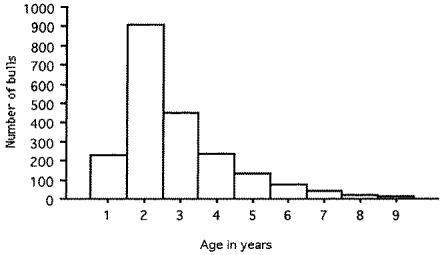
Figure 1. Age distribution of 2110 bulls evaluated at the Western College of Veterinary Medicine from 1986 to 1999.
Table 2.
Effect of breed
The Aberdeen Angus (AA), Charolais (CH), Hereford (H), Limousin (LM), and Simmental (SM) breeds represented 92.3% of the bulls in a total of 17 breeds. After adjusting for differences in month of testing and age at testing, SM bulls (OR, 1.9; 95 % CI, 1.3 to 2.7) and AA bulls (OR, 1.4; 95% CI, 1.1 to 2.0) were significantly more likely to be classified as satisfactory on BSE than were H, LM, or CH breeds (Table 3). There were no differences in the percentages of bulls by breed that were classified as questionable; however, SM bulls were the least likely to be classified as unsatisfactory. Simmental remained more likely to be classified as satisfactory after adjusting for BCS, SC, age, and month of test. Simmental (OR, 1.9; 95% CI, 1.4 to 2.7), AA (OR, 1.6; 95% CI, 1.1 to 2.3), and LM (OR, 1.4; 95% CI, 1.0 to 2.0) bulls were more likely to have a satisfactory semen quality evaluation than were H or CH.
Table 3.
Effect of body condition score
Only 3 bulls had a BCS > 4 at the time of BSE, and of these, 1 bull with a BCS of 4.5 had satisfactory semen quality (Table 4). When only physically normal bulls (but, including those with body conditions related to obesity) were considered as a group over the entire year, significantly fewer bulls with a BCS of 2.0 had satisfactory semen quality than bulls with a BCS of 3.0 (OR, 2.3; 95% CI, 1.4 to 4.0). Significantly fewer bulls with a BCS of 4.0 or greater had satisfactory semen quality than bulls with a BCS of 3.0 (OR, 3.5; 95% CI, 2.6 to 4.8). There was no difference in semen quality for bulls with a BCS of 2.5 to 3.5. Bulls with a BCS of 2.0 to 3.5 improved in semen quality between the 1st and 2nd quarter of the year (OR, 1.8; 95% CI, 1.5 to 2.3).
Table 4.
Effect of physical abnormalities
Of 1432 physically normal bulls with a BCS of 2.5 to 3.5, 82.6% had satisfactory semen quality. The number of bulls with a BCS of 2.5 to 3.5 that had one or more physical abnormalities was 386 (20.4%); however, depending on the type and severity, physical abnormalities did not necessarily preclude a satisfactory classification of potential breeding soundness. There were 466 (22.1%) of all bulls that had at least one physical abnormality. The proportions of all physical abnormalities recorded (n = 494) are summarized in Table 5.
Table 5.
The percentages of bulls with satisfactory semen quality in the presence of abnormalities of the feet and legs, the scrotum, and the testes were 59.5%, 34.7%, and 7.7%, respectively. Visible, or palpable physical abnormalities of the testes (OR, 35.2; 95% CI, 19.8 to 62.3), scrotum (OR, 6.3; 95% CI, 4.7 to 8.4), or epididymides (OR, 8.9; 95% CI, 4.1 to 19.5) decreased the odds of satisfactory semen quality.
Of 131 bulls with normal body condition (BCS of 2.5 to 3.5) and no physical abnormalities, except foot and leg abnormalities, including lame bulls, 89 bulls (67.9%) had satisfactory semen quality. Of 115 bulls with normal body condition and no physical abnormalities, except foot and leg abnormalities, not including lame bulls, 85 bulls (73.9%) had satisfactory semen quality. Feet and leg abnormalities that did not result in lameness were not significantly associated with semen quality (OR, 1.4; 95% CI, 0.9 to 1.9). Lameness was a very important factor affecting semen quality (OR, 4.5; 95% CI, 2.0 to 10.8), as only 4 of 17 lame bulls had a satisfactory rating.
Effect of frostbite
No cases of scrotal frostbite were recorded in the months of November or December; therefore, it appears that most cases occurred during January and February. However, it is quite likely that some cases of scrotal frostbite occurred in December and that the affected bulls were not presented until the following month, or later. Bulls with slight frostbite to the base of the scrotum, resulting in 1 or 2 scabs < 2 cm in diameter, did not significantly decrease the percentage of bulls with satisfactory semen quality compared with physically normal bulls (OR, 1.0; 95% CI, 0.6 to 1.6). However, more severe frostbite resulting in 1 or more scabs > 2 cm in diameter had a marked adverse effect on semen quality of affected bulls compared with that of physically normal bulls (OR, 8.3; 95% CI, 7.2 to 13.9). There were 58 bulls with large frostbite scabs on the base of the scrotum from January through June. None were found to have satisfactory semen quality in the months of January through March. In April, only 2 of 22 (9.1%) bulls with large frostbite scabs had satisfactory semen quality. However, 10 of 19 (52.6%) bulls with large frostbite scabs that were tested in May and June had satisfactory semen quality (Table 6).
Table 6.
There was no relationship between the frequency of frostbite and SC (P > 0.85) or BCS (P > 0.26); however, there was a correlation between age and the percentage of bulls with frostbite (r = 0.71). None of the yearling bulls had frostbite, but as age increased, the frequency of frostbite increased significantly, up to the age of 6 y. For example, bulls 5 and 6 y of age were more likely (OR, 4.3; 95% CI, 2.5 to 7.2) to have frostbite than 2-year-old bulls. Bulls 7 y or older had a decline in the frequency of frostbite, but the frequency of frostbite was still significantly higher than in 1- and 2-year-old bulls.
Effect of scrotal circumference
A significantly lower number of bulls with below average (OR, 1.7; 95% CI, 1.2 to 2.4) or below the recommended minimum (OR, 7.0; 95% CI, 5.0 to 9.9) SC had satisfactory semen quality than did bulls with average and above average SC (Table 7, Figure 2). Significantly more bulls with below average SC had satisfactory semen quality than did bulls with below the recommended minimum SC (OR, 4.1; 95% CI, 2.6 to 6.5).
Table 7.

Figure 2. The relationship of scrotal circumference with semen quality.
Bulls with below the recommended minimum SC had lower numbers of morphologically normal sperm (difference, 19.7%; 95% CI, 16.1% to 21.3%) and sperm staining alive (difference, 11.1%; 95% CI, 7.9% to 14.3%) than bulls with average (or above average) SC measurements (Table 7). There was no difference in numbers of morphologically normal sperm and sperm staining alive between bulls with average, above average, and below average SC. Bulls with below minimum SC (difference, 17.9%; 95% CI, 14.2% to 21.6%) and below average (difference, 5.0%; 95% CI, 1.3 to 8.8) SC had lower percentages of progressively motile sperm than bulls with average (or above average) SC.
Bulls with below the recommended minimum SC had higher numbers of sperm with midpiece defects (difference, 4.4%; 95% CI, 2.7% to 6.1%), proximal droplets (difference, 2.5%; 95% CI, 1.3% to 3.7%) and detached heads (difference, 2.6%; 95% CI, 1.2% to 4.1%) than bulls with average (or above average) SC measurements (Table 8). There were no differences in the occurrence of these defects among bulls with average, above average, or below average SC measurements. Bulls with below the recommended minimum (difference, 6.9%; 95% CI, 5.3% to 8.5%) and below average (difference, 2.5%; 95% CI, 0.9% to 4.1%) SC had higher numbers of sperm with head defects than bulls with average (or above average) SC measurements (Table 8). There were no differences in the occurrence of head defects among bulls with average or above average SC measurements.
Table 8.
Association between semen quality traits
Estimates of the percentage of progressively motile sperm (% motile), the percentage of sperm that did not take up eosin stain in eosin-nigrosin-stained semen smears (% alive), and the percentage of morphologically normal sperm (% normal) were available for 1722 bulls. Over all cases, regardless of semen quality, the % motile and % alive were highly correlated (r = 0.84, P < 0.0001). The % motile (r = 0.69, P < 0.0001) and % alive (r = 0.60, P < 0.0001) were also both correlated with % normal.
Data on the percentages of progressively motile sperm and sperm staining alive were available in 1296 bulls with ≥ 70% morphologically normal sperm. Only 46 (3.5%) of these bulls had < 60% progressively motile sperm. Of these 46 bulls, 22 were rated as satisfactory potential breeders, presumably because the percentage of sperm staining alive was > 60%. Twenty-four of these bulls were rated as questionable potential breeders because of low numbers of living sperm or because of a high percentage of sperm tail defects.
The percentage of sperm with midpiece defects declined and the percentage of sperm with head defects increased slightly with the approach of spring and summer in bulls with questionable and unsatisfactory semen quality (Figure 3). In these bulls, the percentage of sperm with midpiece defects was significantly higher from January (difference, 10.0%; 95% CI, 2.9% to 17.1%) through May (difference, 5.0%; 95% CI, 0.75 to 9.4%) than in June. The percentage of sperm with head defects was slightly lower in March (difference, 4.1%; 95% CI, 0.1% to 8.1%) and April (difference, 5.6%; 95% CI, 1.7% to 9.6%) than in June. There were no significant differences among the other months and June. A similar pattern of differences in midpiece and head defects among months was seen in all bulls (data not shown).
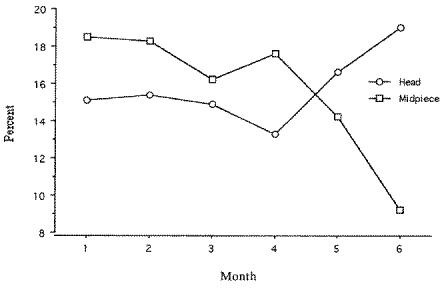
Figure 3. Changes in the percentages of sperm head and midpiece defects in physically normal bulls with questionable or unsatisfactory semen quality from January to mid-June.
Discussion
Overall, only 65.8% of bulls were classified as satisfactory potential breeders. This is considerably lower than reported by previous workers, who found that 76.4% to 83.5% of bulls were classified as satisfactory (8,9,10). One of the reasons for the lower percentage of satisfactory bulls in the present study may be due to a greater stress effect of more severe winters in western Canada than in the United States (9,10) and to less winter shelter being provided for them than for bulls studied in Sweden (8). In the present study, the percentage of bulls with satisfactory semen quality increased as time progressed from the colder months of January and February toward the warmer months of May and June. This resulted in increasing percentages of bulls with satisfactory BSE classifications as time progressed toward the warmer months. The improvement in semen quality occurred in all bulls, including physically normal bulls in normal body condition. This suggests that a combination of a short photoperiod, cold stress, and reduced feed quality may be detrimental to spermatogenesis. Feed quality is less likely to be a factor affecting semen quality than either of the former, since significantly more bulls had satisfactory semen quality in March and April than in January and February, despite being on the same supply of stored feed. A lower proportion of bulls in poor body condition had satisfactory semen quality than did bulls in good body condition. Although the adverse effects of undernourishment can not be discounted, the effect of cold stress could be expected to be more severe in bulls without adequate body fat. Since nearly all bulls in western Canada are kept outdoors throughout the winter, producers must ensure that bulls have adequate shelter from wind and a good supply of clean, dry bedding.
Adequate levels of blood and testis testosterone are known to be important for normal spermatogenesis (27,28). Therefore, photoperiod may have an effect on semen quality, since seasonal variation in luteinizing hormone and testosterone has been reported in bulls (28,29,30,31). In 4 Norwegian red bulls, blood testosterone levels were significantly lower in October and December than in February, June, and August (29). However, there is some conflict in the literature regarding the relationship between season and testosterone concentrations in bulls. Studies on seasonal effects on hormone secretion and spermatogenesis must be interpreted carefully, since latitude, housing, climatic heat, or cold stress could influence testosterone levels. In addition, there is diurnal variation in LH and testosterone levels; therefore, frequent blood sampling throughout a large portion of the day is necessary as a basis for comparison of hormone levels at different times of the year. Not all studies have been adequate in this regard. Further studies on the effect of photoperiod on endocrine hormone secretions affecting spermatogenesis in bulls are needed.
Another reason for the lower percentage of bulls with a satisfactory classification in this study compared with other studies might be due to the time of year when studies were conducted. In the present study, many of the medical records indicated that the reason for a BSE during, or shortly after, the main breeding season (spring-summer) was that producers had observed a high number of returns to estrus in the cow-herd. Therefore, bulls that are evaluated prior to the main breeding season may be more likely to have a satisfactory BSE classification than are those presented during or after the breeding season. The work of Carroll et al (9) did not include the months of July through September; however, the studies of Lagerlof (8) and Elmore et al (10) included bulls tested over entire years. In the present study, a higher percentage of bulls had satisfactory semen quality and BSE classifications from January to mid-June (66.9%) than in late June to December (58.4%). A higher percentage of bulls had satisfactory BSE classifications prior to the main breeding season than after the breeding season, despite the disadvantage of the preceding winter period.
The percentage of bulls with satisfactory BSE classifications and satisfactory semen quality declined in August and September. It appeared that a large proportion of bulls classified as questionable or unsatisfactory in August and September had physical abnormalities. However, considering only physically normal bulls, a significantly lower proportion of bulls had satisfactory semen quality in September than in the months of March through August (P < 0.03). This would suggest that other seasonal factors, such as the decline in photoperiod and a decline in the nutritional quantity and quality of pasture, may be involved in the decline of semen quality of physically sound bulls as fall approaches. The reason for the rise in the percentage of bulls with satisfactory breeding soundness classifications and satisfactory semen quality in the month of October is not clear, but it may be due to a short period of trade on the older-bull market. Producers often sell bulls with satisfactory breeding soundness at the end of a breeding season when the bulls have completed 3 y of service, to prevent inbreeding of daughters selected as replacement heifers. These older, proven bulls are sought by other producers, who submit them for evaluation as a condition of sale. The proportion of satisfactory bulls begins to decline again in November and December. Part of the reason for this decline may again be due to the seasonal decline in photoperiod and nutritional resources. In addition, pregnancy testing is most heavily concentrated in the months of October and November. Thus, when producers find unsatisfactory pregnancy rates, suspect bulls are submitted for semen evaluation. The percentage of satisfactory bulls is higher in October through December than in August and September. This may be due to a combination of proven bulls submitted for presale evaluation and bulls suspected to be subfertile during the breeding season having had time to recover from their problems. Examples include immature yearling bulls that matured, fat bulls that lost weight, and lame bulls that recovered from lameness.
A higher percentage of 2-year-old bulls suffered from physical abnormalities and obesity than did 1-, 3-, and 4-year-old bulls; however, all age groups older than 2 y of age had higher percentages of bulls affected by scrotal frostbite. Despite having less scrotal frostbite, fewer 2-year-old bulls had satisfactory semen quality than did older bulls and yearling bulls. Physical abnormalities and obesity could account for the lower proportions of 2-year-old bulls with satisfactory semen quality. It is a common practice for purebred breeders to place bulls on high energy rations to maximize growth as yearlings and to fit 2-year-old bulls for sale. High energy rations are less likely to cause obesity in yearling bulls than in 2-year-old bulls, because the high energy feeding period is of shorter duration for yearling bulls. Most older bulls would be on maintenance rations on the farms of commercial producers and, therefore, would also be less prone to obesity than would 2-year-old bulls. Many 2-year-old bulls with physical abnormalities would develop mating problems, or their physical abnormalities would become more pronounced, during their first breeding season, resulting in culling. Due to the culling of physically abnormal 2-year-old bulls, older bulls would have fewer physical abnormalities and, consequently, a higher proportion would have satisfactory semen quality.
The effect of breed on BSE classification was compared for the AA, CH, H, LM, and SM breeds, because large numbers of bulls were available for these breed categories. A numerically higher percentage of SM bulls had satisfactory BSE classifications than did CH, H, LM, and AA breeds. However, the difference was significant only for the SM breed vs. the CH, H, and LM breeds. The proportions of semen evaluations by month were similar for these 5 breeds, and SM bulls did not have fewer physical abnormalities than did the other breeds. There are 2 possible reasons for a higher percentage of SM bulls having a satisfactory BSE classification: (1) fewer SM bulls than bulls from the other breeds had a BCS ≤ 2.5 or ≥ 4.0, and the difference was significant for the SM vs. the AA and H breeds; and (2) more SM bulls had above average SC than did bulls from the other breeds, and the difference was significant for SM vs. CH, H, and LM breeds. Fewer SM bulls had below the minimum recommended SC than the other breeds, but the difference was significant only for SM vs. LM bulls. The effect of breed on semen quality classification was also compared among these breeds. Although SM bulls had a numerically higher percentage with satisfactory semen quality, a significant difference was seen only in SM vs. CH and H bulls.
Only 3 bulls had a BCS > 4 and, of these, 1 bull with a BCS of 4.5 had satisfactory semen quality. When only physically normal bulls were considered (but still including those with conditions related to obesity) as a group over the entire year, significantly fewer bulls with a BCS of 2.0 had satisfactory semen quality than did bulls with a BCS of 3.0 or 3.5. Low body condition in mid winter would likely indicate inadequate nutrition for regaining weight lost during the breeding season and, possibly, weight loss. Others have reported a decline in testes size and tone in undernourished bulls; however, semen quality was not examined (33). Significantly fewer bulls with a BCS of 4.0 had satisfactory semen quality than did bulls with a BCS of 2.5 to 3.5. In many cases, the records indicated that excess fat could be palpated within the scrotum of these bulls. Fat deposits around the testicular cords and in the scrotum have been associated with abnormal thermoregulation of the testes (12,14,34). As with the majority of bulls, semen quality improved in bulls with a BCS of 2.0 as the warmer months approached, and this might be expected as the stress of winter is left behind. However, in bulls with a BCS ≥ 4.0, semen quality declined with the approach of spring. A possible explanation for this is that some bulls gained a great deal of weight on winter rations and the longer they were gaining weight, the greater was the likelihood that they would accumulate excess fat in the scrotum.
Physical abnormalities of the feet and legs did not significantly affect the proportion of bulls with satisfactory semen quality; however, when lameness was present, semen quality was severely affected, as only 4 of 16 lame bulls had satisfactory semen quality. This is not unexpected, since pain in the feet and legs would adversely affect the endocrine secretion of LH and reduce testosterone secretion that is important in the maintenance of normal spermatogenesis (13,35). Foot and leg abnormalities, such as the corkscrew claw defect, or post-like hind legs that did not cause lameness were not associated with a decrease in semen quality. However, conditions such as these might predispose bulls to developing lameness at a later date.
It appears that scrotal frostbite occurs quite commonly in western Canadian beef bulls, as a total of 125 cases were recorded in this data set (5.9% of all bulls). The most likely mechanism for a disturbance of spermatogenesis in cases of frostbite is an increase in testicular temperature due to inflammation of the scrotum. Slight frostbite to the base of the scrotum did not significantly decrease the percentage of bulls with satisfactory semen quality. Apparently, the amount of scrotal inflammation in these bulls was of insufficient duration and severity to have a noticeable adverse effect on spermatogenesis. However, severe frostbite had a marked adverse effect on semen quality, since no bulls with large scrotal frostbite scabs had satisfactory semen quality in the months of January through March, and even by May and June, only 52.6% of bulls had recovered sufficiently to produce satisfactory semen quality. None of the yearling bulls had frostbite, but as age increased, the frequency of frostbite increased significantly. Yearling bulls and 2-year-old bulls might receive more attention from breeders who are raising them for sale purposes, so one might expect less frostbite in these age groups; however, it is difficult to explain why older bulls, mainly maintained in commercial herds, were more susceptible to frostbite. Clearly, provision of adequate bedding and shelter to wintering bulls is of great importance to prevent losses of bull breeding potential.
A great deal of emphasis is placed on the selection of bulls with large SC measurements as a means for selecting for early puberty (7). In this study, a significantly higher number of bulls with above average or average SC had satisfactory semen quality than did bulls with a below average, or below the recommended minimum, SC. This provides some assurance that the current recommended practices of bull selection based on SC are also valid for increasing the likelihood that a bull will produce good quality semen. Others have reported significant positive correlations of SC with good semen quality (16,36,37).
Sperm motility and morphology have been shown to be significantly correlated to bull fertility (5,38,39,40). As such, the main semen quality traits evaluated in bull BSE in the systems of the Society for Theriogenology and the WCABP are the percentage of progressively motile sperm and percentage of morphologically normal sperm (7,41). However, in one study, poor motility in the presence of good morphology was not associated with reduced fertility (42). In the BSE system of the WCABP, the percentage of sperm not taking up eosin stain (staining alive) is included in semen evaluation. Over all cases in this study, regardless of semen quality, the % motile and % alive were highly significantly correlated and the % motile and % alive were both significantly correlated to the percentage of morphologically normal sperm. Therefore, an evaluation of % alive and % motile should be good estimates of sperm viability when semen quality is good; however, when there is a high percentage of abnormal sperm tails, % motile would underestimate sperm viability.
The BSE systems of the Society for Theriogenology and the WCABP require a minimum of 70% percent morphologically normal sperm. The systems differ, however, in the minimum requirement for the percentage of progressively motile sperm, 30% for the Society and 60% for the WCABP. The data from this study indicated that only 3.5% (46/1307) of bulls having ≥ 70% morphologically normal sperm had less than 60% progressively motile sperm. This indicates than when semen is handled under optimal laboratory conditions, a very high percentage of bulls with good sperm morphology will have a least 60% progressively motile sperm. Of 46 bulls with less than 60% progressively motile sperm, 22 were rated as satisfactory potential breeders, possibly because the percentage of sperm staining alive was > 60%. Twenty-four of these bulls were rated as questionable potential breeders because of low sperm viability or because of a high percentage of sperm tail defects.
Phillips et al (30) reported that abnormal sperm heads were highest in summer and that abnormal sperm tails had the opposite trend, being higher in winter. However, there seemed to be no explanation for this. In the present study, the percentage of sperm with midpiece defects declined significantly, and the percentage of sperm with head defects increased significantly, between March and June. It is difficult to explain this phenomenon. It appears that distal midpiece reflexes increase dramatically in response to stress (13), possibly the stress of winter in this case; however, we decline to offer an explanation for the rise in head defects. It appears that the prognosis for recovery by spring would likely be better for elevated numbers of sperm midpiece defects than for head defects.
In summary, factors that significantly affected breeding soundness classification of bulls in the present study included breed, poor body condition, excessive body condition, lameness, severe frostbite, and below average or below the recommended minimum SC. Cold stress, poor or excessive body condition, and reduced feed quality may interact to reduce semen quality in the winter months. Therefore, producers may need to pay more attention to selection of physically sound bulls with average or above average SC. In addition, producers may need to pay more attention to body condition and winter nutrition of bulls, as well as the provision of adequate shelter and bedding. The short photoperiod in the winter months may also have an adverse effect on spermatogenesis via an effect on gonadotrophin secretion, and this needs to be studied in bulls in western Canada. CVJ
Footnotes
Address correspondence to Dr. Albert Barth.
Reprints will not be available from the author.
References
- 1.Williams WW, Savage A. Methods of determining the reproductive health and fertility of bulls. Cornell Vet 1927;17:374–385.
- 2.McCosker TH, Turner AF, McCool CJ, Post TB, Bell K. Brahman bull fertility in a North Australian rangeland herd. Theriogenology 1989;32:285–300. [DOI] [PubMed]
- 3.Chenoweth PJ. Bull fertility. Mod Vet Pract 1980;61:987–991. [PubMed]
- 4.Farin PW, Chenoweth PJ, Tomky DF, Ball L, Pexton JE. Breeding soundness, libido and performance of beef bulls mated to estrus synchronized females. Theriogenology 1989;32:717–725. [DOI] [PubMed]
- 5.Larsen RE, Littell R, Rooks E, Adams EL, Falcon C, Warnick AC. Bull influences on conception percentage and calving date in Angus, Hereford, Brahman and Senepol single-sire herds. Theriogenology 1990;34:549–568. [DOI] [PubMed]
- 6.Wiltbank JN. Maintenance of a high level of reproductive performance in the beef cow herd. Vet Clin North Am Food Anim Pract 1983;5:41–49. [DOI] [PubMed]
- 7.Barth AD. Bull Breeding Soundness Evaluation Manual. Saskatoon: The Western Canadian Association of Bovine Practitioners, 1994.
- 8.Lagerlof N. Morphologishe unterschungen uber veranderugen im spermabild und in den hoden bei bullen mit verminderter oder aufgehobener fertilitat [Thesis]. Uppsala, Sweden, Acta Pathol Microbiol Scand 1934;Suppl XIX.
- 9.Carroll EJ, Ball L, Scott JA. Breeding soundness in bulls — a summary of 10 940 examinations. J Am Vet Med Assoc 1963;142: 1105–1111. [PubMed]
- 10.Elmore R, Bierschwal CJ, Martin CE, Youngquist RS. A summary of 1127 breeding soundness examinations in beef bulls. Theriogenology 1975;3:209–218.
- 11.Coulter GH, Kozub GC. Testicular development, epididymal sperm reserves and seminal quality in two-year-old Hereford and Angus bulls: effects of two levels of dietary energy. J Anim Sci 1984;59:432–440. [DOI] [PubMed]
- 12.Coulter GH, Cook RB, Kastelic JP. Effects of dietary energy on scrotal surface temperature seminal quality, and sperm production in young beef bulls. J Anim Sci 1997;75:1048–1052. [DOI] [PubMed]
- 13.Barth AD. The sequential appearance of sperm abnormalities after scrotal insulation or dexamethasone treatment in bulls. Can Vet J 1994;34:93–102. [PMC free article] [PubMed]
- 14.Barth AD, Cates WF, Harland RJ. The effect of amount of body fat and loss of fat on breeding soundness classification of bulls. Can Vet J 1995;36:758–763. [PMC free article] [PubMed]
- 15.Palasz AT, Cates WF, Barth AD, Mapletoft RJ. The relationship between scrotal circumference and quantitative testicular traits in yearling beef bulls. Theriogenology 1994;42:715–726. [DOI] [PubMed]
- 16.Rao Veeramachaneni DN, Ott RS, Heath EH, McEntee K, Bolt DJ, Hixon JE. Pathophysiology of small testes in beef bulls: relationship between scrotal circumference, histopathologic features of testes and epididymides, seminal characteristics, and endocrine profiles. Am J Vet Res 1986;47:1988–1999. [PubMed]
- 17.Smith MF, Morris, DL, Amoss MS, Parish NR, Williams JD, Wiltbank JN. Relationships among fertility, scrotal circumference, seminal quality, and libido in Santa Gertrudis bulls. Theriogenology 1981;16:379–397. [DOI] [PubMed]
- 18.Coulter GH, et al. Bovine testicular measurements as indicators of reproductive performance and their relationship to productive traits in cattle: A review. Theriogenology 1979;11:297–311. [DOI] [PubMed]
- 19.Almquist JO, Branas RF, Barber KA. Postpuberal changes in semen production of Charolais bulls ejaculated at high frequency and the relation between testicular measurements and sperm output. J Anim Sci 1976;42:670–676. [DOI] [PubMed]
- 20.Kumi-Diaka J, Nagaratnam V, Rwuaan JS. Seasonal and age related changes in semen quality ad testicular morphology of bulls in a tyropical environment. Vet Rec 1981;108:13–15. [DOI] [PubMed]
- 21.Fields MJ, Burns WC, Warnick AC. Age, season and breed effects on testicular volume and semen traits in young beef bulls. J Anim Sci 1979;48:1299–1304. [DOI] [PubMed]
- 22.Ruttle JL, Ezaz Z, Sceery EJ. Some factors influencing semen characteristics in range bulls. J Anim Sci 1975;41:1069–1073. [DOI] [PubMed]
- 23.Soderquist L, Janson L, Haard M, Einarsson S. Influence of season, age, breed, and some other factors on the variation in sperm morphological abnormalities in Swedish dairy AI bulls. Anim Reprod Sci 1996;44:91–98.
- 24.Wildman EE, Jones GM, Wagner PE, Bowman RL. A dairy cow body condition scoring system and its relationship to selected population characteristics. J Dairy Sci 1982;65:495–501.
- 25.Manual For Breeding Soundness Examination of Bulls. Nashville: J Soc Theriogenology, 1983;12: pp 61.
- 26.Coulter GH, Mapletoft RJ, Kozub GC, Cates WF. Scrotal circumference of two-year-old bulls of several beef breeds. Theriogenology 1987;27:485–491. [DOI] [PubMed]
- 27.Courot M, Hochereau de Reviers MT, Monet-Kuntz C, et al. Endocrinology of spermatogenesis in the hypophysectomized ram. Reprod Fert Suppl 1979;26:165–173. [PubMed]
- 28.Zirkin BR, Santulli R, Awoniyi CA, Ewing LL. Maintenance of advanced spermatogenic cells in the adult rat testis: quantitative relationship to testosterone concentration within the testis. Endocrinology 1989;124:2043–2049. [DOI] [PubMed]
- 29.Sundby A, Tollman R. Plasma testosterone in bulls, seasonal variation. Acta Vet Scand 1978;19:263–268. [DOI] [PMC free article] [PubMed]
- 30.Phillipps RW, Bradford K Jr, Heemstra LC, Eaton ON. Seasonal variation in the semen of bulls. Am J Vet Res 1943;4:115–119.
- 31.Welsh TH Jr, Randel RD, Johnson BH. Interrelationships of serum corticosterioids, LH and testosterone in the male bovine. Arch Androl 1981;6:141–150. [DOI] [PubMed]
- 32.Thibier M. Diurnal testosterone and 17α-hydroxy-progesterone in peripheral plasma of young post-pubertal bulls. Acta Endocrinol 1976;81:623–634. [PubMed]
- 33.Ndama PH, Entwistle KW, Lindsay JA. Effect of protected protein supplements on some testicular traits in Brahman cross bulls. Theriogenology 1983;20:639–650.
- 34.Coulter GH, Kozub GC. Testicular development, epididymal sperm reserves and seminal quality in two-year-old Hereford and Angus bulls: effects of two levels of dietary energy. J Anim Sci 1984;59:432–440. [DOI] [PubMed]
- 35.Welsh TH Jr, Johnson BH. Stress-induced alterations in secretion of corticosteroids, progesterone, luteinizing hormone, and testosterone in bulls. Endocrinology 1981;109:185–190. [DOI] [PubMed]
- 36.Gibson TA, Vogt DW, Massey JW. Associations of scrotal circumference with semen traits in young beef bulls. Theriogenology 1985;24:217–225. [DOI] [PubMed]
- 37.Cates WF. Observations on scrotal crcumference and its relationship to classification of bulls. Proc Annu Meet Soc Theriogenology, Cheyenne, 1975.
- 38.Peet RL, Kluck P, McCarth M. Infertility in 2 Murray Grey bulls associated with abaxial and swollen midpiece sperm defects. Aust Vet J 1998;65:359–360. [DOI] [PubMed]
- 39.Barth AD, Oko RJ. Abnormal Morphology of Bovine Spermatozoa. Iowa: Iowa State Univ Pr, 1989:285 pp.
- 40.Soderquist L, Janson L, Larsson K, Einarsson S. Sperm morphology and fertility in AI bulls. J Vet Med 1991;38:534–543. [DOI] [PubMed]
- 41.Chenoweth PJ. A new breeding soundness evaluation form. Proc Soc Theriogenol, San Antonio, 1992:pp 63–70.
- 42.Wiltbank JN. Evaluation of bulls for potential fertility. Proc Annu Meet Soc Theriogenol, Milwaukee, 1982:pp 141–154.



